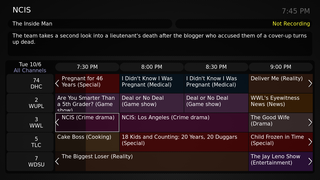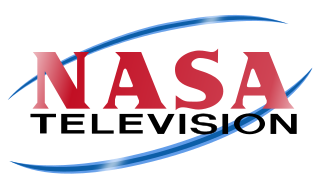
Cable television is a system of delivering television programming to consumers via radio frequency (RF) signals transmitted through coaxial cables, or in more recent systems, light pulses through fibre-optic cables. This contrasts with broadcast television, in which the television signal is transmitted over-the-air by radio waves and received by a television antenna attached to the television; or satellite television, in which the television signal is transmitted over-the-air by radio waves from a communications satellite orbiting the Earth, and received by a satellite dish antenna on the roof. FM radio programming, high-speed Internet, telephone services, and similar non-television services may also be provided through these cables. Analog television was standard in the 20th century, but since the 2000s, cable systems have been upgraded to digital cable operation.

A television channel, or TV channel, is a terrestrial frequency or virtual number over which a television station or television network is distributed. For example, in North America, channel 2 refers to the terrestrial or cable band of 54 to 60 MHz, with carrier frequencies of 55.25 MHz for NTSC analog video (VSB) and 59.75 MHz for analog audio (FM), or 55.31 MHz for digital ATSC (8VSB). Channels may be shared by many different television stations or cable-distributed channels depending on the location and service provider
A television broadcaster or television network is a telecommunications network for the distribution of television content, where a central operation provides programming to many television stations, pay television providers or, in the United States, multichannel video programming distributors. Until the mid-1980s, broadcast programming on television in most countries of the world was dominated by a small number of terrestrial networks. Many early television networks such as the BBC, CBS, CBC, NBC or ABC in the US and in Australia evolved from earlier radio networks.
Television receive-only (TVRO) is a term used chiefly in North America, South America to refer to the reception of satellite television from FSS-type satellites, generally on C-band analog; free-to-air and unconnected to a commercial DBS provider. TVRO was the main means of consumer satellite reception in the United States and Canada until the mid-1990s with the arrival of direct-broadcast satellite television services such as PrimeStar, USSB, Bell Satellite TV, DirecTV, Dish Network, Sky TV that transmit Ku signals. While these services are at least theoretically based on open standards, the majority of services are encrypted and require proprietary decoder hardware. TVRO systems relied on feeds being transmitted unencrypted and using open standards, which heavily contrasts to DBS systems in the region.
A satellite dish is a dish-shaped type of parabolic antenna designed to receive or transmit information by radio waves to or from a communication satellite. The term most commonly means a dish which receives direct-broadcast satellite television from a direct broadcast satellite in geostationary orbit.

Television is one of the major mass media outlets in the United States. In 2011, 96.7% of households owned television sets; about 114,200,000 American households owned at least one television set each in August 2013. Most households have more than one set. The percentage of households owning at least one television set peaked at 98.4%, in the 1996–1997 season. In 1948, 1 percent of U.S. households owned at least one television; in 1955, 75 percent did. In 1992, 60 percent of all U.S. households had cable television subscriptions.
Simulcast is the broadcasting of programs or events across more than one resolution, bitrate or medium, or more than one service on the same medium, at exactly the same time. For example, Absolute Radio is simulcast on both AM and on satellite radio. Likewise, the BBC's Prom concerts were formerly simulcast on both BBC Radio 3 and BBC Television. Another application is the transmission of the original-language soundtrack of movies or TV series over local or Internet radio, with the television broadcast having been dubbed into a local language.
Free-to-air (FTA) services are television (TV) and radio services broadcast in unencrypted form, allowing any person with the appropriate receiving equipment to receive the signal and view or listen to the content without requiring a subscription, other ongoing cost, or one-off fee. In the traditional sense, this is carried on terrestrial radio signals and received with an antenna.
Superstation is a term in North American broadcasting that has several meanings. Commonly, a "superstation" is a form of distant signal, a broadcast television signal—usually a commercially licensed station—that is retransmitted via communications satellite or microwave relay to multichannel television providers over a broad area beyond its primary terrestrial signal range.

WPCH-TV, branded on-air as Peachtree TV, is a television station in Atlanta, Georgia, United States, affiliated with The CW. It is owned by locally based Gray Television alongside CBS affiliate and company flagship WANF, and low-power, Class A Telemundo affiliate WKTB-CD. WPCH-TV and WANF share studios on 14th Street Northwest in Atlanta's Home Park neighborhood; WPCH-TV's transmitter is located in the Woodland Hills section of northeastern Atlanta.
In broadcasting, channel playout is the generation of the source signal of a radio or television channel produced by a broadcaster, coupled with the transmission of this signal for primary distribution or direct-to-audience distribution via any network. Such radio or television distribution networks include terrestrial broadcasting, cable networks, satellites, IPTV, OTT Video, point-to-point transport over managed networks or the public Internet, etc.
A pirate television station is a broadcast television station that operates without a broadcast license. Like its counterpart pirate radio, the term pirate TV lacks a specific universal interpretation. It implies a form of broadcasting that is unwelcome by the licensing authorities within the territory where its signals are received, especially when the country of transmission is the same as the country of reception. When the area of transmission is not a country, or when it is a country and the transmissions are not illegal, those same broadcast signals may be deemed illegal in the country of reception. Pirate television stations may also be known as "bootleg TV", or confused with licensed low-power broadcasting (LPTV) or amateur television (ATV) services.
In broadcasting, digital subchannels are a method of transmitting more than one independent program stream simultaneously from the same digital radio or television station on the same radio frequency channel. This is done by using data compression techniques to reduce the size of each individual program stream, and multiplexing to combine them into a single signal. The practice is sometimes called "multicasting".

Satellite television is a service that delivers television programming to viewers by relaying it from a communications satellite orbiting the Earth directly to the viewer's location. The signals are received via an outdoor parabolic antenna commonly referred to as a satellite dish and a low-noise block downconverter.
In broadcasting, local insertion is the act or capability of a broadcast television station, radio station or cable system to insert or replace part of a network feed with content unique to the local station or system. Most often this is a station identification, but is also commonly used for television or radio advertisements, or a weather or traffic report. A digital on-screen graphic, commonly a translucent watermark, may also be keyed (superimposed) with a television station ID over the network feed using a character generator using genlock. In cases where individual broadcast stations carry programs separate from those shown on the main network, this is known as regional variation or an opt-out.

A free-to-air or FTA Receiver is a satellite television receiver designed to receive unencrypted broadcasts. Modern decoders are typically compliant with the MPEG-2/DVB-S and more recently the MPEG-4/DVB-S2 standard for digital television, while older FTA receivers relied on analog satellite transmissions which have declined rapidly in recent years.

A television production truck or OB van is a small mobile production control room to allow filming of events and video production at locations outside a regular television studio. They are used for remote broadcasts, outside broadcasting (OB), and electronic field production (EFP). Some require a crew of as many as 30 people, with additional trucks for additional equipment as well as a satellite truck, which transmits video back to the studio by sending it up through a communications satellite using a satellite dish, which then transmits it back down to the studio. Alternatively, some production trucks include a satellite transmitter and satellite dish for this purpose in a single truck body to save space, time and cost.

NASA TV is the television service of the National Aeronautics and Space Administration (NASA). It is broadcast by satellite with a simulcast over the Internet. Local cable television providers across the United States and amateur television repeaters may carry NASA TV at their own discretion, as NASA-created content is considered a work of the U.S. government and is within the public domain. NASA TV is also available via various cable, satellite, and over-the-top media services worldwide. The network was formally created in the early 1980s to provide NASA managers and engineers with real-time video of missions. NASA has operated a television service since the beginning of the space program for archival purposes, and to provide media outlets with video footage.

WGN America was an American subscription television network that operated from November 9, 1978 to February 28, 2021. The service was originally uplinked to satellite by United Video Inc. as a national feed of Chicago independent station WGN-TV, making the station's programming available to cable and satellite providers throughout the United States as the second nationally distributed "superstation".








